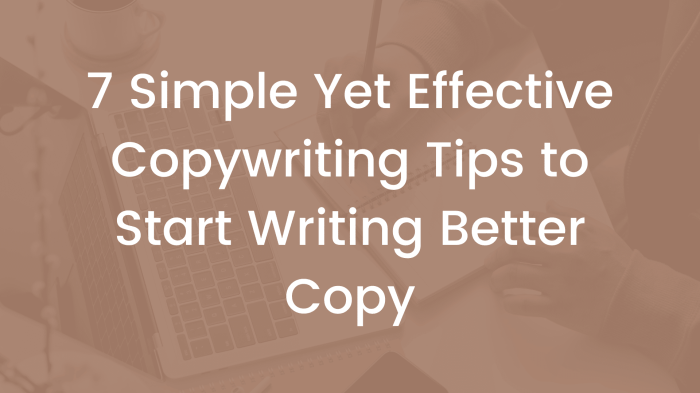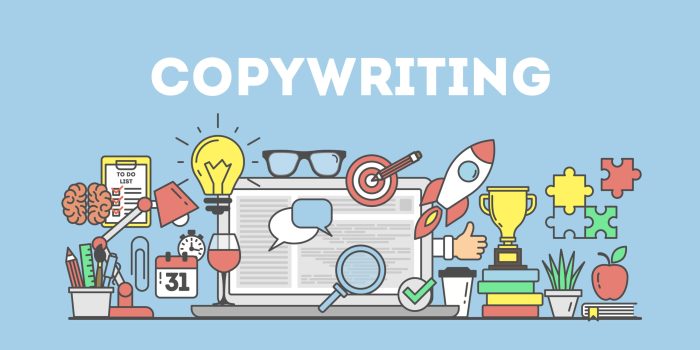Effective Copywriting Tips: Get ready to elevate your writing game with these powerful strategies that will take your content to the next level. From crafting compelling headlines to utilizing storytelling techniques, this guide has got you covered.
Importance of Effective Copywriting
Effective copywriting is like the secret sauce for businesses looking to stand out in a crowded market. It’s all about crafting compelling messages that resonate with your target audience, driving them to take action. Whether it’s creating engaging website content, catchy social media posts, or persuasive ad copy, effective copywriting can make or break a brand’s success.
Examples of Successful Campaigns, Effective Copywriting Tips
- Apple’s “Think Different” campaign: By using simple yet powerful copywriting, Apple positioned itself as a revolutionary brand, appealing to customers’ emotions and values.
- Nike’s “Just Do It” slogan: This iconic phrase became synonymous with the brand’s message of empowerment and determination, driving sales and brand loyalty.
Impact on Conversion Rates
Effective copywriting can significantly impact conversion rates by influencing how customers perceive a brand and its products. Compelling copy can create a sense of urgency, highlight key benefits, and address customer pain points, ultimately motivating them to make a purchase.
Understanding the Target Audience: Effective Copywriting Tips
Knowing your target audience is crucial in copywriting as it allows you to tailor your message to resonate with them effectively. By understanding their needs, preferences, and pain points, you can create copy that truly connects with them.
The Importance of Researching and Understanding the Target Audience
Researching your target audience involves gathering data on demographics, psychographics, and behavior patterns. This information helps you create buyer personas that represent your ideal customers. Understanding their motivations and challenges allows you to craft copy that addresses their specific needs.
- Conduct surveys, interviews, and focus groups to gather insights directly from your target audience.
- Utilize analytics tools to track website traffic, engagement metrics, and customer behavior.
- Monitor social media channels to observe conversations, trends, and feedback from your audience.
Tailoring your copy to the audience can significantly improve engagement and conversion rates.
How Tailoring Copy to the Audience Improves Engagement
When you speak directly to your target audience through personalized messaging, you create a sense of connection and relevance. By addressing their specific pain points, desires, and aspirations, you can capture their attention and compel them to take action.
- Use language and tone that resonates with your audience’s preferences and communication style.
- Highlight benefits that are most valuable to your audience, showcasing how your product or service solves their problems.
- Include testimonials, case studies, and success stories that demonstrate real-life examples of how your offering has helped others like them.
Crafting Compelling Headlines

Headlines play a crucial role in copywriting as they are the first thing that catches the reader’s attention. A compelling headline can make or break the success of your copy. It’s the gateway to the rest of your content, so it needs to be engaging and enticing.
Significance of Headlines
- Headlines are the first impression: They are the first thing readers see, and a captivating headline can draw them in to read more.
- Headlines set the tone: They give readers a glimpse of what to expect in the rest of the copy, setting the tone and generating interest.
- Headlines impact click-through rates: A well-crafted headline can significantly increase click-through rates, leading to more engagement and conversions.
Tips for Creating Attention-Grabbing Headlines
- Be specific and clear: Use concise language to convey the main benefit or message of your copy.
- Use power words: Incorporate strong, action-oriented words that evoke emotion and prompt action.
- Create curiosity: Pose a question or tease a solution to pique the reader’s interest and compel them to keep reading.
- Use numbers or statistics: People are drawn to concrete data, so including numbers can make your headline more compelling.
- Test and refine: Experiment with different headline styles and formats to see what resonates best with your target audience.
Impact of Headlines on Click-Through Rates
- A catchy headline can increase click-through rates by grabbing the reader’s attention and enticing them to learn more.
- Headlines that address a specific pain point or offer a solution are more likely to drive clicks and engagement.
- Testing different headlines and analyzing the click-through rates can help optimize your copy and improve overall performance.
Writing Persuasive Copy

To be able to effectively persuade your audience, it is crucial to understand the key differences between informative and persuasive copy. While informative copy aims to provide information and educate the reader, persuasive copy focuses on convincing the reader to take a specific action.
Techniques for Making Copy More Persuasive
- Use emotional appeal: Connect with your audience on a deeper level by appealing to their emotions. This can be done through storytelling, using vivid language, and highlighting the benefits of your product or service.
- Provide social proof: Incorporate testimonials, reviews, and success stories from satisfied customers to build credibility and trust with your audience.
- Create a sense of urgency: Encourage immediate action by using phrases like “limited time offer” or “act now” to create a sense of urgency and scarcity.
- Address objections: Anticipate and address any potential objections your audience may have. By acknowledging and overcoming these objections in your copy, you can build trust and credibility.
Psychology Behind Persuasive Writing
- Reciprocity: Offer value to your audience before asking for anything in return. By providing valuable information or resources, you can create a sense of reciprocity and increase the likelihood of a positive response.
- Authority: Position yourself as an expert in your field to establish credibility and trust with your audience. Use statistics, case studies, and endorsements to showcase your expertise.
- Scarcity: Highlight the limited availability of your product or service to create a sense of urgency and drive action. By emphasizing scarcity, you can increase the perceived value of what you’re offering.
- Consistency: Encourage small commitments from your audience to build momentum towards larger commitments. By getting your audience to take small steps towards your desired outcome, you can increase the likelihood of conversion.
Utilizing Storytelling in Copywriting
Storytelling is a powerful tool in copywriting that can captivate the audience, evoke emotions, and create a connection with the brand. By incorporating storytelling techniques, copywriters can make their content more engaging and memorable, ultimately leading to better results.
Examples of Brands Using Storytelling
- Apple: The tech giant is known for its iconic storytelling in its advertising campaigns, focusing on the emotional connection people have with their products rather than just the features.
- Dove: Dove’s “Real Beauty” campaign tells stories of real women to promote body positivity and self-acceptance, resonating with their audience on a personal level.
- Coca-Cola: Coca-Cola’s classic Christmas commercials are a perfect example of storytelling that creates a sense of nostalgia and joy, associating the brand with positive emotions.
Incorporating Storytelling Techniques
- Start with a compelling hook to grab the reader’s attention and set the tone for the story.
- Develop relatable characters or situations that the audience can connect with on an emotional level.
- Create a cohesive narrative that flows smoothly and keeps the reader engaged until the end.
- Use descriptive language and sensory details to paint a vivid picture and evoke emotions in the audience.
- End with a strong call-to-action that ties back to the story and encourages the audience to take the desired action.